Plesionectes longicollum, a new plesiosaur from Germany
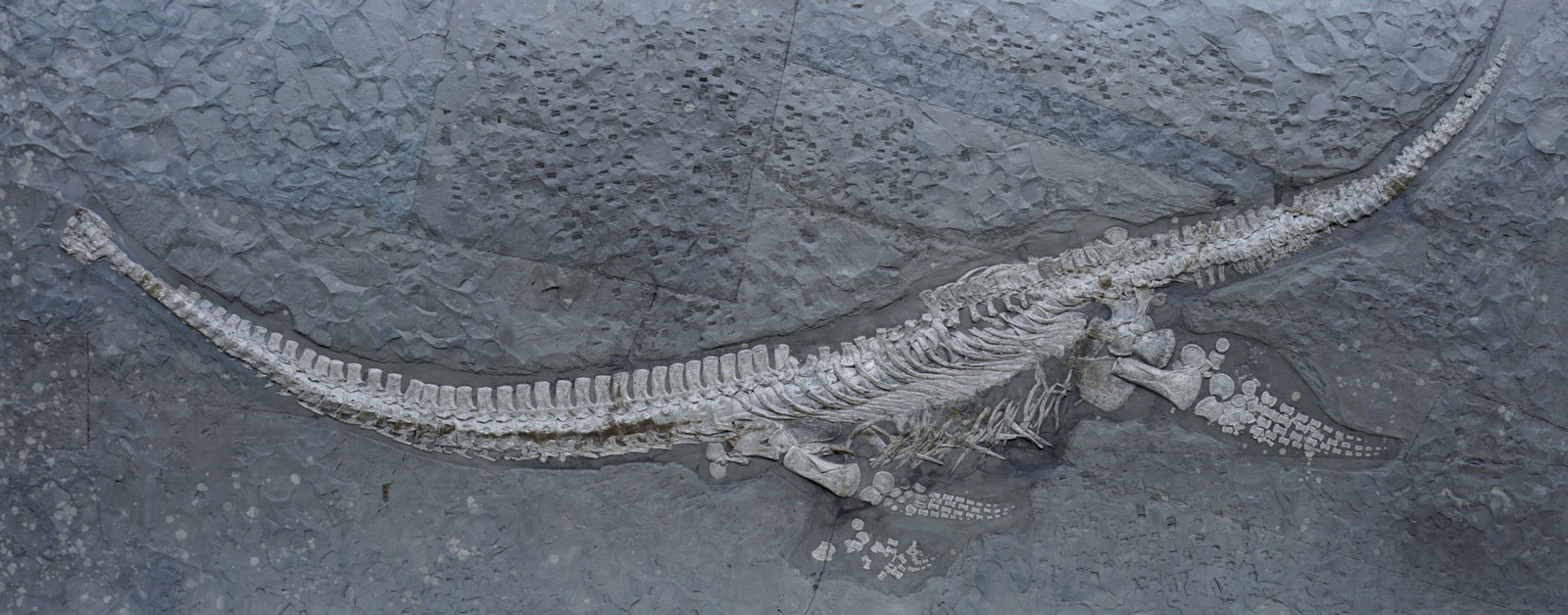
A long-necked plesiosauroid from the Lower Jurassic Posidonia Shale of Holzmaden
by Sven Sachs & Daniel Madzia
Plesionectes longicollum is a plesiosauroid plesiosaur from Holzmaden in Baden-Württemberg, Southwest Germany. My colleague Daniel Madzia and I established this new genus and species in 2025 in the journal PeerJ (Sachs & Madzia, 2025). The skeleton of Plesionectes is a remarkably well-preserved, nearly complete specimen housed in the collection of the Staatliches Museum für Naturkunde Stuttgart, where it is cataloged under the number SMNS 51945. The fossil is embedded in a slab of Posidonia Shale, a bituminous claystone also known as oil shale, from the lower Toarcian of the Lower Jurassic. While the skeleton is largely articulated and complete, the skull is not as well preserved, and only parts of it can be identified. Despite being a small town with fewer than 800 inhabitants, Holzmaden is world-renowned in the scientific community for its wealth of superbly preserved fossils. Thousands of ichthyosaurs have been discovered here and are now displayed in museums around the world. Plesiosaurs are far less common, with only about 13 more-or-less complete skeletons found to date. One of them is SMNS 51945, the specimen that became Plesionectes longicollum.
Brief history of the specimen
The history of the Plesionectes specimen is relatively short. It was discovered in 1978 by Gotthilf Fischer in his own quarry in Holzmaden. Fischer, who also operated a small museum across the street from the Urweltmuseum Hauff, prepared the plesiosaur himself. During this process, he used brownish repair plaster to fix some parts of the skeleton. The fossil was later acquired by the Staatliches Museum für Naturkunde in Stuttgart. Over the years, the specimen has been featured in several publications, including Der Posidonienschiefer des unteren Juras und seine Fossilien by Urlichs et al. (1994) and the book Der schwäbische Lindwurm (Ziegler, 1986), where it was identified as Plesiosaurus. Wild (1989) later suggested it might be a species of Microcleidus. In 2006, Franziska Großmann provided a brief description of the specimen (SMNS 51945) in her PhD thesis on plesiosauroids from the Posidonia Shale. A more detailed description was later published by Vincent et al. (2017), though their paper focused primarily on the fossilized soft-tissue samples preserved at the neck, tail, and hind limbs. Both Großmann (2006) and Vincent et al. (2017) concluded that SMNS 51945 appeared to be a new type of plesiosaur, but neither formally established a new taxon for the specimen.
Characteristics of Plesionectes longicollum
Plesionectes has a unique combination of anatomical features that distinguish it from other plesiosaurs. The most striking feature is the exceptionally long neck. The preserved neck bears 41 cervical vertebrae, but since the atlas-axis complex is missing, the minimum count is 43 cervicals. We believe that one or two more vertebrae might also be missing. If that’s the case, Plesionectes would have the longest neck of any known Lower Jurassic plesiosaur. The minimum count of 43 neck vertebrae is otherwise only found in Microcleidus tournemirensis (formerly known as Occitanosaurus tournemirensis) from the upper Toarcian of southern France (Bardet et al., 1999). Microcleidus belongs to the clade Microcleididae, which is characterized by extremely tall neural spines in the posterior cervical, pectoral, and dorsal vertebrae. These neural spines can be more than three times as tall as they are long. This distinguishes Plesionectes, as its neural spines are generally less than twice as tall as they are long. Another key feature is the high number of dorsal vertebrae. Plesionectes has 20 to 21 dorsal vertebrae, which is the second-highest count among all Lower Jurassic plesiosaurs. Only Franconiasaurus brevispinus has more, with 22 dorsals (Sachs et al., 2024). Other characteristics include a long paraoccipital process that is 1.5 times as long as the exoccipital body is tall, which distinguishes it from the coeval Plesiopterys wildi. Plesionectes also has V-shaped neurocentral sutures in all cervical and pectoral vertebrae, a feature we consider a potential local autapomorphy. Additionally, most of the cervical vertebrae have two conjoined cervical rib facets, which transition to a single facet in the posteriormost cervicals. The anterior and mid-cervical ribs also show a pronounced anterior and posterior cervical rib process.
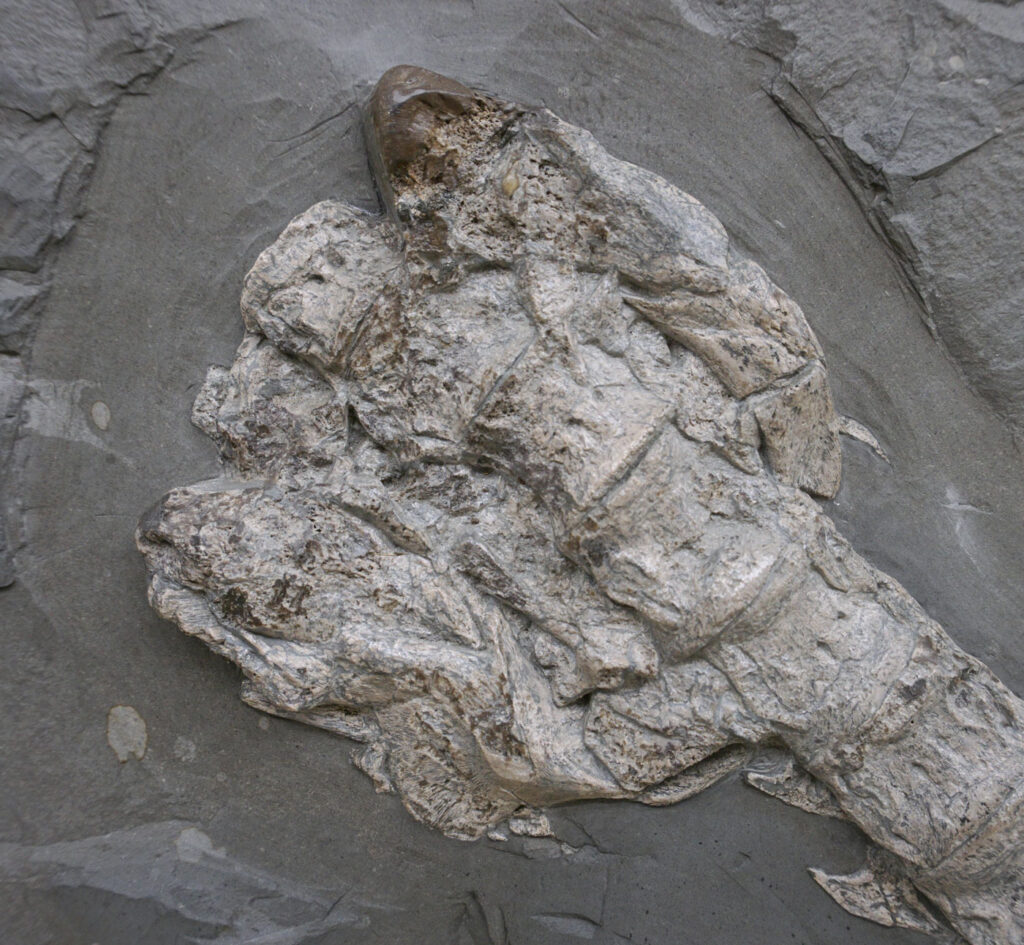
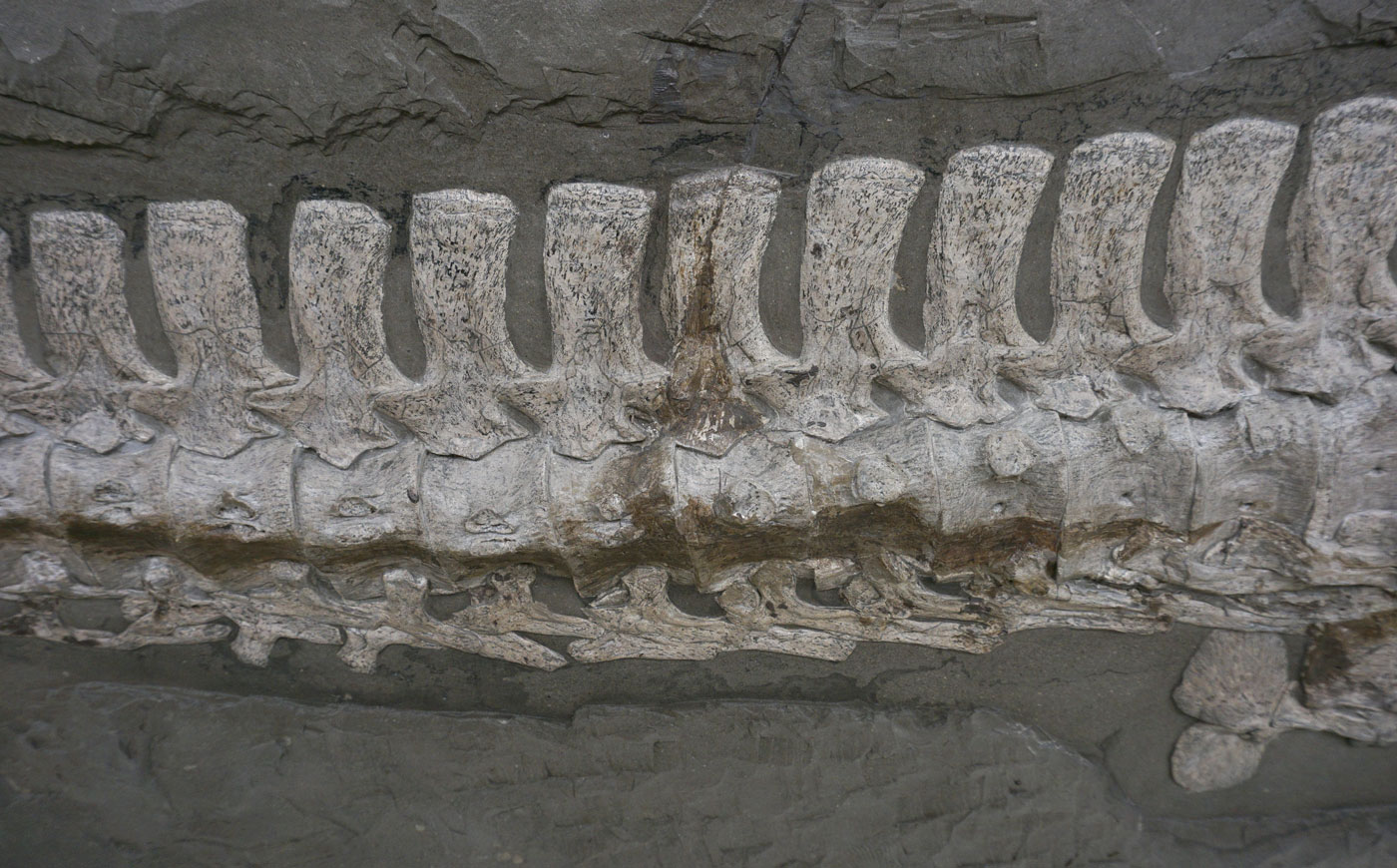
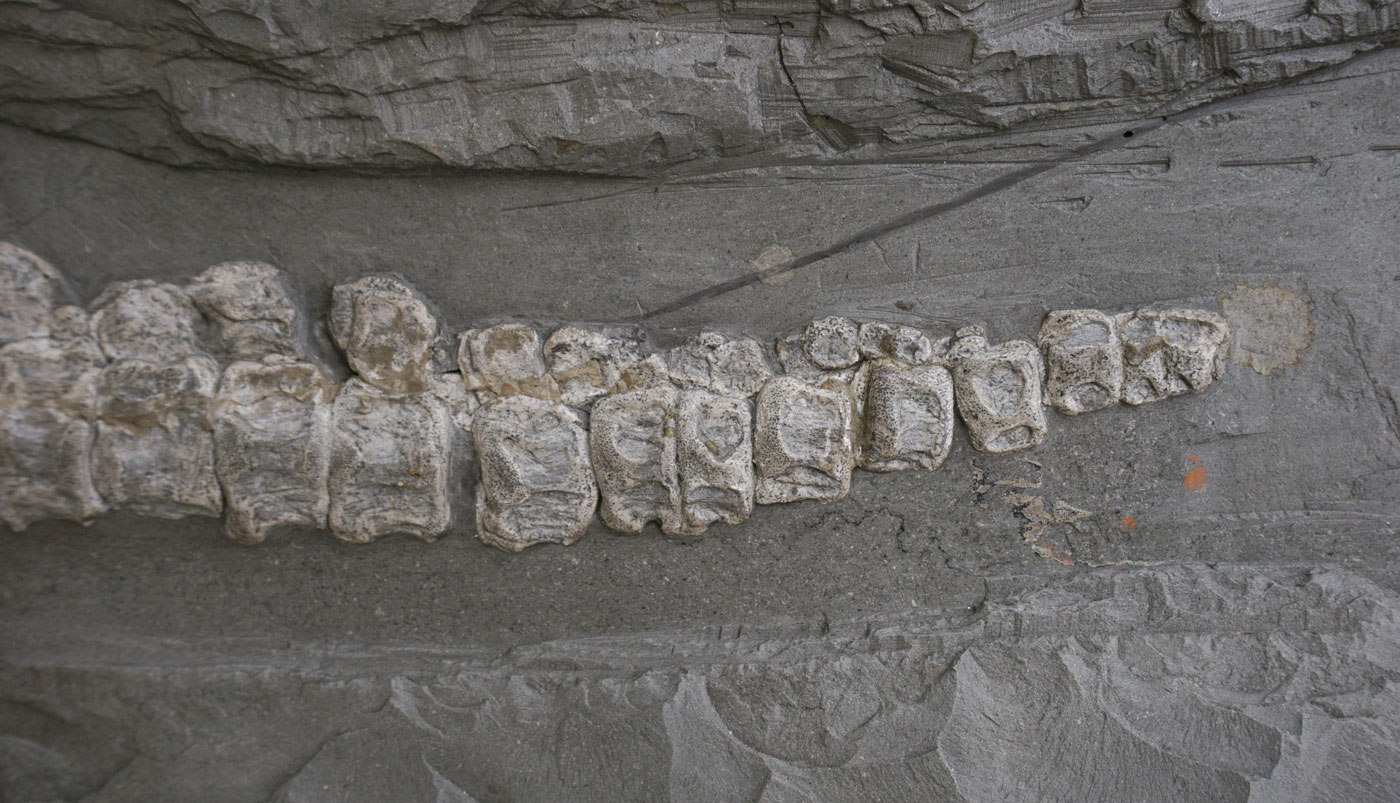
Ontogenetic stage and variation
The holotype specimen SMNS 51945 shows some anatomical traits which have been considered as an indicator for a non-adult or osteologically immature (sensu Araújo et al., 2015) ontogenetic stage. These include unfused neurocentral sutures and epipodial facets on the propodials that are not distinctly angled. However, other characteristics, such as a pronounced anteromedial process on the ischium, suggest the specimen wasn’t a young juvenile, based on Brown’s (1981) original definition. This is further supported by its length of 295 cm, as preserved, thus likely 320 cm when complete (note that some vertebrae are shifted and that the skull is largely smashed). Plesionectes was thus larger than most of the contemporary plesiosaurs of the Posidonia Shale. To assess the ontogenetic variability of the characters we considered diagnostic for Plesionectes, we used the phylogenetically useful characters defined in the matrix of Benson & Druckenmiller (2014) that contains 270 characters. We examined the Posidonia Shale plesiosaur Plesiopterys wildi, for which two specimens are known that show different growth stages. The holotype SMNS 16812 is a young specimen that measures 2.20 m in length. The referred specimen MH 7 is 3.00 m long. We found that of the 112 characters that we could assess in both specimens, 98 showed only minor modification. Ontogenetic variation mainly affected characters in the limbs and girdle elements. We also checked Seeleyosaurus guilelmiimperatoris and Franconiasaurus brevispinus, where the holotypes are likewise smaller than the referred specimens, and came to a similar result. This said, we cannot exclude that the specimen is in fact an adult that shows paedomorphic traits, as per Araújo & Smith (2023).

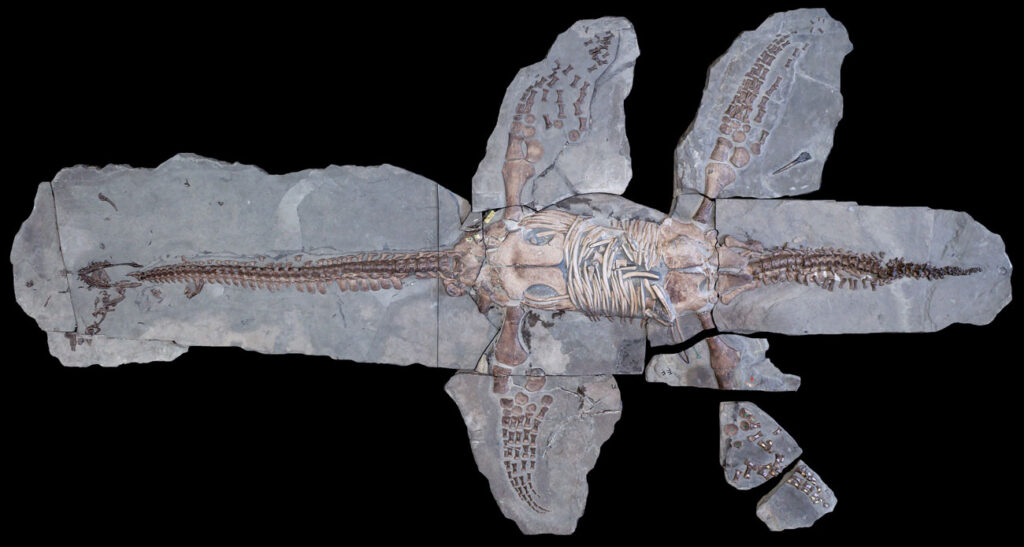
Oldest plesiosaur of the Posidonia Shale
The Plesionectes holotype not only shows a unique combination of character states and is notably large, but it also comes from a different horizon than other plesiosaurs from that unit. The specimen was found in the lowermost part of the midsection of the Posidonia Shale, the so-called Lias Epsilon II1, whereas most plesiosaur specimens derive from the younger Lias Epsilon II3 and II4. This makes Plesionectes longicollum the oldest plesiosaur genus in the Posidonia Shale and underlines the uniqueness of the taxon.
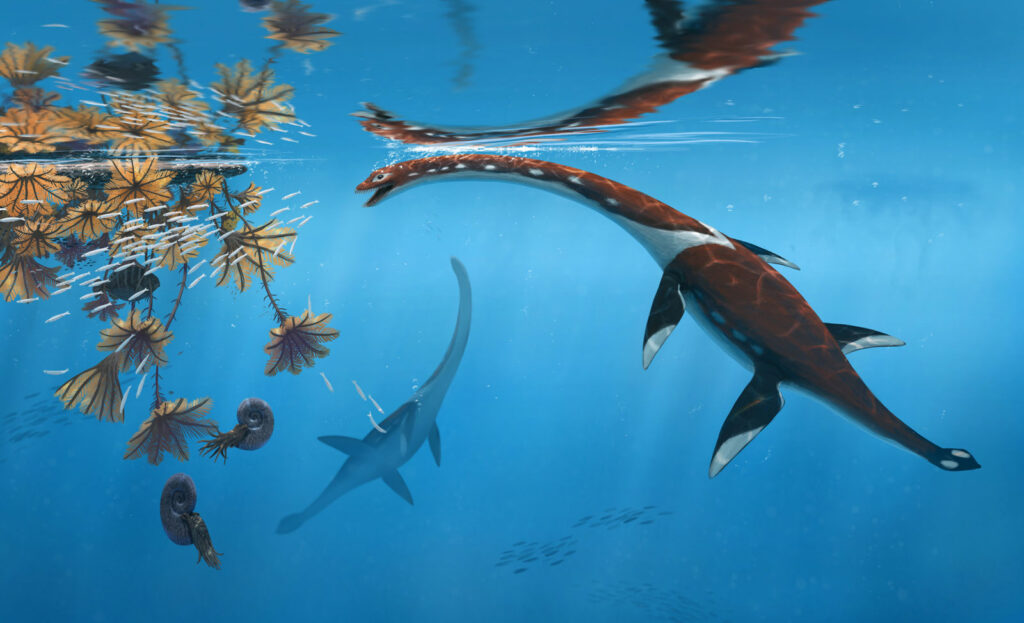
Citations
Benson RBJ, Druckenmiller PS. 2014. Faunal turnover of marine tetrapods during the Jurassic-Cretaceous transition. Biological Reviews 89(1):1–23
Brown DS. 1981. The English Upper Jurassic Plesiosauroidea (Reptilia) and a review of the phylogeny and classification of the Plesiosauria. Bulletin of the British Museum (Natural History) Geology 35:253–347.
Urlichs M, Wild R, Ziegler B. 1994. Der Posidonienschiefer des unteren Juras und seine Fossilien. Stuttgarter Beiträge zur Naturkunde, Serie C 36:1–95.
Vincent P, Allemand R, Taylor PD, Suan G, Maxwell EE. 2017. New insights on the systematics, palaeoecology and palaeobiology of a plesiosaurian with soft tissue preservation from the Toarcian of Holzmaden, Germany. The Science of Nature 104:1–13
Wild R. 1989. Das Grabungsschutzgebiet, Versteinerungen Holzmaden. In: Ministerium für Wissenschaft und Kunst Baden-Württemberg, ed. Forschung an den Staatlichen Naturkundemuseen Baden-Württemberg. Schriftenreihe des Ministeriums für Wissenschaft und Kunst Baden-Württemberg zur Bildungsforschung, Bildungsplanung, Bildungspolitik. Nr. 52. Villingen: Neckar Verlag, 90–94.
Ziegler B. 1986. Der schwäbische Lindwurm –Funde aus der Urzeit im Museum am Löwentor. Stuttgart: Theiss.
—
- The image of the referred specimen of Plesiopterys wildi (MH 7) was kindly provided by Miguel Marx.
- This study is part of the grant project Global drivers of plesiosaur evolution during intervals of intense change in Mesozoic marine ecosystems. National Science Centre, Poland, Grant no. 2023/51/B/NZ8/00899 (awarded to Daniel Madzia, Institute of Paleobiology of the Polish Academy of Sciences).
